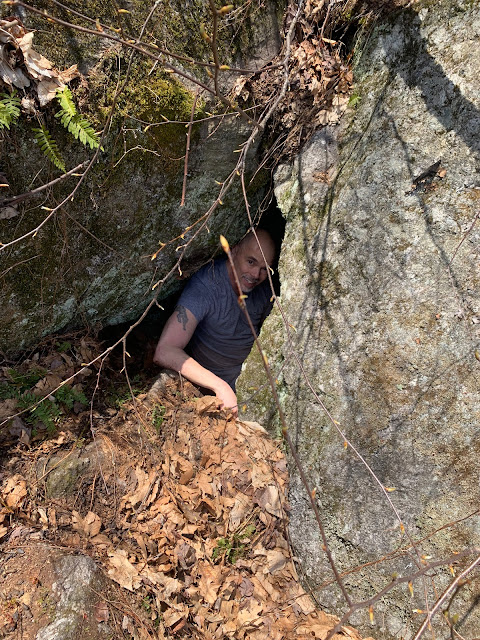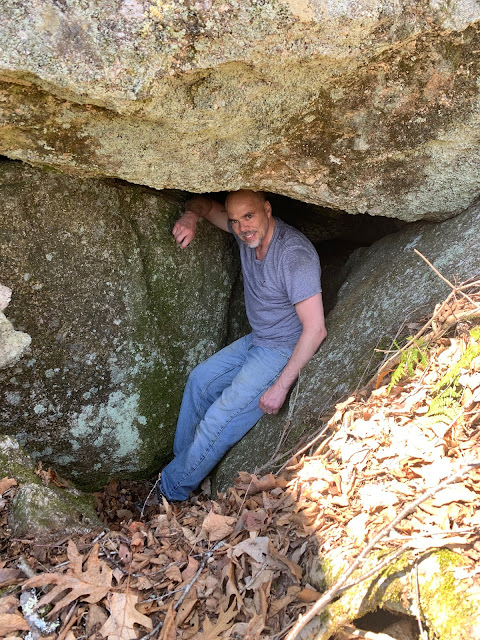Raymond Cave is in the side of Raymond Cliff, near Everett station. Its opening is large enough for a man to comfortably enter erect. For the first forty feet it is about twelve feet high and eight feet wide, then for the next forty feet it is of smaller dimensions. It is very cold in summer. The cave is formed of huge, angular blocks which have fallen from the cliff above.
In 1876 John Clough paid $16.76 in taxes for 339 acres of property he owned in eastern Weare, near the bordering town of Dunbarton. Although a pittance by today's standards, these taxes were something he paid for year after year to hold on to the land, refusing to sell despite many offers. Clough loved this area and feared that if he sold the land it would be logged, and in 1932 he deeded the property to the State of NH, forever preserving it. A subsequent lawsuit trimmed the state's portion down to 150 acres, but Clough would be happy to know that nearly 100 years after gifting it away we still have his former property to enjoy, now known as the Clough State Park.
No matter which trail you start off with the first thing you're going to notice is the 2,000 foot long Hopkinton Everett Dam, situated smack in the middle of everything. Completed in the 1960s after years in the making, this 115 foot tall structure is part of the Hopkinton-Everett Lakes Flood Risk Management Project, a mouthful of a project put into place to end a series of devastating floods that rampaged this area in the first part of the 1900s.
Our son Logan joined us for this trip, but it wasn't to admire the engineering of the dam or for any history lessons. To the west of the park are the Raymond Cliffs, and they are loaded with all sort of rocks and ledges to climb on, one of his favorite pastimes that doesn't require a keyboard and a mouse.
And for anyone without a teenager of their own, when you go climbing with your 16-year old son this is their idea of waiting up for you.
Logan had his own motive for coming here, and my wife Tina did as well. I have taken her on some hellacious hikes over the years, but today meant an afternoon of walking on her perfect idea of what a trail should be - flat, near water, spacious, and most importantly without any bushwhacking.
Then there was me - and I was here for the caves. These ledges are a playground for all sorts of caverns and cubbyholes to explore. Many are small like this one, dark places where you're apt to go eyeball to eyeball with a porcupine or something equally cuddly.
Other caves were much larger. Steve Higham mapped these ledges in the June 2017 edition of The Northeastern Caver, with three of them being large enough to qualify for a name. There is the Lower Carr Cave, the Devils Step Cave (a name you'll understand if you navigate its southern entrance), and the largest and most well know of this area, the Raymond Cave. It's a mid-size cave as far as New Hampshire goes, measuring 99 feet in length, and throwing in the historical aspect makes for a really cool place to explore.
After our afternoon of playing - I was able to find all three of the named caves - we still had one more quest to complete. John Clough left his mark on society by giving us all this land, but he left his mark in a more literal sense, as well. Look for the largest free-standing boulder at the base of the Raymond Cliffs, then take a walk around it toward its water-side. Although perhaps not as prominent as it was a hundred years ago, where he engraved his name on this boulder is still clear enough to read to this today: John Clough.
Clough State Park is one of those places where we hadn't even left the parking lot and we were already planning our next trip here. This is a beautiful and unique area that has something to offer for anyone who doesn't like spending their weekends on the couch. That describes probably every single one of our friends, and we look forward to introducing them to this place when, and hopefully not if, our world returns to normal.
References:









I grew up only 3 miles down the road from Clough State Park and spent most days of my childhood exploring those rocks. I am impressed you were able to find all of those spots that took me years of exploring to find. If you had come even just a few months earlier the crowds would have been a lot different. The state park didn't even open for several years and seeing anyone else there, besides the few familiar faces, was very rare. I am selfishly upset to see the park actually being used. JK. When Covid and quarantines came, Everybody suddenly decided they wanted to spend time outside and they have flooded the park. The Crowds have brought so good change like fixing the litter problem and pushing out teens that would ruin the park. It's sad to see the park change but I'm happy that people get to discover the same secrets in the park as I did.
ReplyDeleteThanks for the comment! I had some clues as to what was out there for caves, so I didn't go in totally blind, but I still had to find them and was happy to have done so. I've notice the same thing with parks near my house, they became busy during covid and have remained that way ever since. This makes me happy, and for the times I want solitude I just go a little deeper into the woods :)
DeleteDave
My brother and I explored those caves back in the 60s. We found something like 8 of them ..
DeleteMy brother and I explored them in the 60s as well. I think we found 8 to 10 of them. Most of them were small but 1 was huge about 100 feet back 6 to 8 feet in the front entrance and 6 to 8 feet high. Spent nights there like camping out. First time I believe was 1965 and had to talk to the damn control officer a Mr. LEDGERE at the time. His son, Mike was my best friend at the time. I did get permission at the time but time went by and Ledger moved with family to Russell Massachusetts and a man by the name of Plifka ran the damn. I do remember spending 3 nights in the big cave it was alot of fun. One ti.e we saw a bear in the cave but next day he was gone.
DeleteWhat fun times! Those are great memories you have, thank you for sharing them - Dave :)
DeleteWould like to find these caves - where did you locate the clues?
ReplyDeleteVery well put together and informative. It is important to document for others in the future.Cheers.
ReplyDeleteThank you :)
Delete